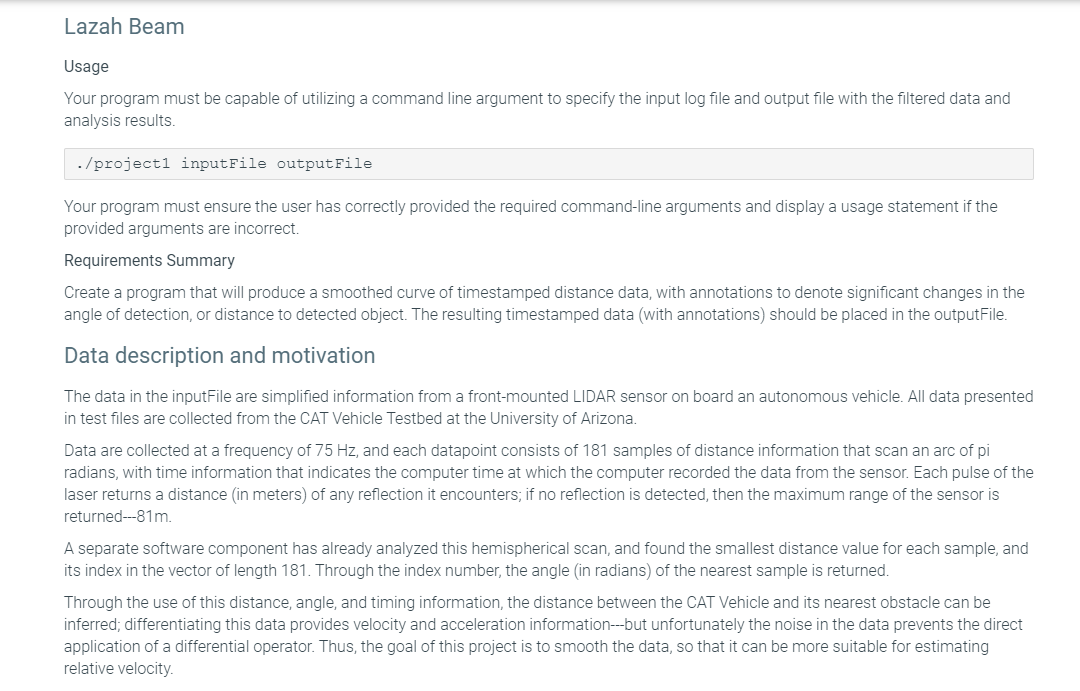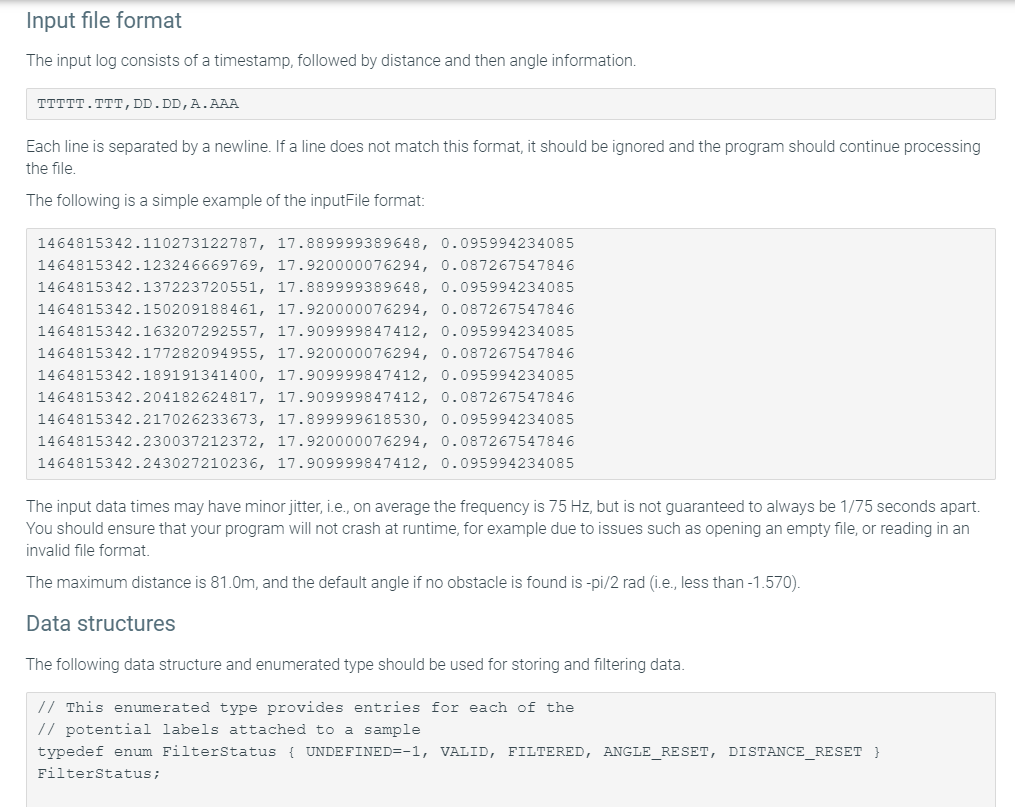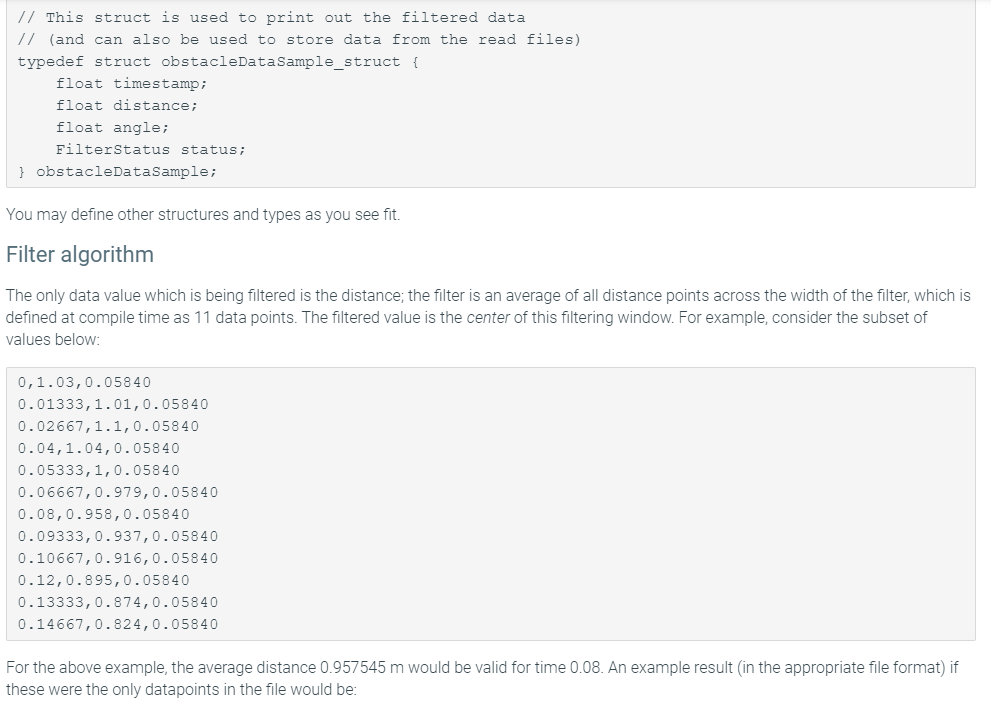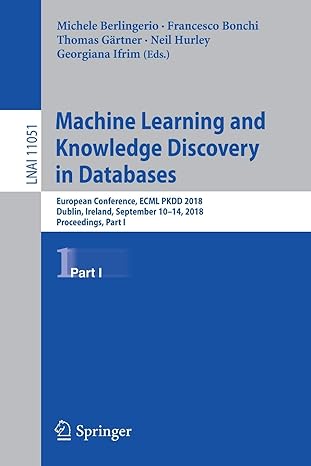Answered step by step
Verified Expert Solution
Question
1 Approved Answer
in c++ please. Below I have posted the example Inputs for inputFile1.txt 1464815342.270047187805, 17.889999389648, 0.095994234085 1464815342.284098386765, 17.909999847412, 0.087267547846 1464815342.297166585922, 17.920000076294, 0.095994234085 1464815342.310261487961, 17.909999847412, 0.087267547846 Lazah
in c++ please.



Below I have posted the example Inputs for inputFile1.txt
1464815342.270047187805, 17.889999389648, 0.095994234085 1464815342.284098386765, 17.909999847412, 0.087267547846 1464815342.297166585922, 17.920000076294, 0.095994234085 1464815342.310261487961, 17.909999847412, 0.087267547846
Lazah Beam Usage Your program must be capable of utilizing a command line argument to specify the input log file and output file with the filtered data and analysis results. ./project1 input File output File Your program must ensure the user has correctly provided the required command-line arguments and display a usage statement if the provided arguments are incorrect. Requirements Summary Create a program that will produce a smoothed curve of timestamped distance data, with annotations to denote significant changes in the angle of detection, or distance to detected object. The resulting timestamped data (with annotations) should be placed in the outputFile. Data description and motivation The data in the inputFile are simplified information from a front-mounted LIDAR sensor on board an autonomous vehicle. All data presented in test files are collected from the CAT Vehicle Testbed at the University of Arizona. Data are collected at a frequency of 75 Hz, and each datapoint consists of 181 samples of distance information that scan an arc of pi radians, with time information that indicates the computer time at which the computer recorded the data from the sensor. Each pulse of the laser returns a distance in meters) of any reflection it encounters; if no reflection is detected, then the maximum range of the sensor is returned---81m. A separate software component has already analyzed this hemispherical scan, and found the smallest distance value for each sample, and its index in the vector of length 181. Through the index number, the angle in radians) of the nearest sample is returned. Through the use of this distance, angle, and timing information, the distance between the CAT Vehicle and its nearest obstacle can be inferred; differentiating this data provides velocity and acceleration information---but unfortunately the noise in the data prevents the direct application of a differential operator. Thus, the goal of this project is to smooth the data, so that it can be more suitable for estimating relative velocity Input file format The input log consists of a timestamp, followed by distance and then angle information. TTTTT.TTT, DD.DD, A. AAA Each line is separated by a newline. If a line does not match this format, it should be ignored and the program should continue processing the file. The following is a simple example of the inputFile format: 1464815342.110273122787, 17.889999389648, 0.095994234085 1464815342.123246669769, 17.920000076294, 0.087267547846 1464815342.137223720551, 17.889999389648, 0.095994234085 1464815342.150209188461, 17.920000076294, 0.087267547846 1464815342.163207292557, 17.909999847412, 0.095994234085 1464815342.177282094955, 17.920000076294, 0.087267547846 1464815342.189191341400, 17.909999847412, 0.095994234085 1464815342.204182624817, 17.909999847412, 0.087267547846 1464815342.217026233673, 17.899999618530, 0.095994234085 1464815342.230037212372, 17.920000076294, 0.087267547846 1464815342.243027210236, 17.909999847412, 0.095994234085 The input data times may have minor jitter, i.e., on average the frequency is 75 Hz, but is not guaranteed to always be 1/75 seconds apart. You should ensure that your program will not crash at runtime, for example due to issues such as opening an empty file, or reading in an invalid file format. The maximum distance is 81.Om, and the default angle if no obstacle is found is -pi/2 rad i.e., less than-1.570). Data structures The following data structure and enumerated type should be used for storing and filtering data. // This enumerated type provides entries for each of the // potential labels attached to a sample typedef enum Filterstatus { UNDEFINED=-1, VALID, FILTERED, ANGLE_RESET, DISTANCE_RESET } FilterStatus; // This struct is used to print out the filtered data // (and can also be used to store data from the read files) typedef struct obstacleDataSample_struct { float timestamp; float distance; float angle; FilterStatus status; } obstacleDataSample; You may define other structures and types as you see fit. Filter algorithm The only data value which is being filtered is the distance, the filter is an average of all distance points across the width of the filter, which is defined at compile time as 11 data points. The filtered value is the center of this filtering window. For example, consider the subset of values below: 0,1.03,0.05840 0.01333,1.01,0.05840 0.02667,1.1,0.05840 0.04,1.04,0.05840 0.05333,1,0.05840 0.06667,0.979,0.05840 0.08,0.958,0.05840 0.09333,0.937,0.05840 0.10667, 0.916,0.05840 0.12,0.895,0.05840 0.13333,0.874,0.05840 0.14667,0.824,0.05840 For the above example, the average distance 0.957545 m would be valid for time 0.08. An example result in the appropriate file format) if these were the only datapoints in the file would be: Lazah Beam Usage Your program must be capable of utilizing a command line argument to specify the input log file and output file with the filtered data and analysis results. ./project1 input File output File Your program must ensure the user has correctly provided the required command-line arguments and display a usage statement if the provided arguments are incorrect. Requirements Summary Create a program that will produce a smoothed curve of timestamped distance data, with annotations to denote significant changes in the angle of detection, or distance to detected object. The resulting timestamped data (with annotations) should be placed in the outputFile. Data description and motivation The data in the inputFile are simplified information from a front-mounted LIDAR sensor on board an autonomous vehicle. All data presented in test files are collected from the CAT Vehicle Testbed at the University of Arizona. Data are collected at a frequency of 75 Hz, and each datapoint consists of 181 samples of distance information that scan an arc of pi radians, with time information that indicates the computer time at which the computer recorded the data from the sensor. Each pulse of the laser returns a distance in meters) of any reflection it encounters; if no reflection is detected, then the maximum range of the sensor is returned---81m. A separate software component has already analyzed this hemispherical scan, and found the smallest distance value for each sample, and its index in the vector of length 181. Through the index number, the angle in radians) of the nearest sample is returned. Through the use of this distance, angle, and timing information, the distance between the CAT Vehicle and its nearest obstacle can be inferred; differentiating this data provides velocity and acceleration information---but unfortunately the noise in the data prevents the direct application of a differential operator. Thus, the goal of this project is to smooth the data, so that it can be more suitable for estimating relative velocity Input file format The input log consists of a timestamp, followed by distance and then angle information. TTTTT.TTT, DD.DD, A. AAA Each line is separated by a newline. If a line does not match this format, it should be ignored and the program should continue processing the file. The following is a simple example of the inputFile format: 1464815342.110273122787, 17.889999389648, 0.095994234085 1464815342.123246669769, 17.920000076294, 0.087267547846 1464815342.137223720551, 17.889999389648, 0.095994234085 1464815342.150209188461, 17.920000076294, 0.087267547846 1464815342.163207292557, 17.909999847412, 0.095994234085 1464815342.177282094955, 17.920000076294, 0.087267547846 1464815342.189191341400, 17.909999847412, 0.095994234085 1464815342.204182624817, 17.909999847412, 0.087267547846 1464815342.217026233673, 17.899999618530, 0.095994234085 1464815342.230037212372, 17.920000076294, 0.087267547846 1464815342.243027210236, 17.909999847412, 0.095994234085 The input data times may have minor jitter, i.e., on average the frequency is 75 Hz, but is not guaranteed to always be 1/75 seconds apart. You should ensure that your program will not crash at runtime, for example due to issues such as opening an empty file, or reading in an invalid file format. The maximum distance is 81.Om, and the default angle if no obstacle is found is -pi/2 rad i.e., less than-1.570). Data structures The following data structure and enumerated type should be used for storing and filtering data. // This enumerated type provides entries for each of the // potential labels attached to a sample typedef enum Filterstatus { UNDEFINED=-1, VALID, FILTERED, ANGLE_RESET, DISTANCE_RESET } FilterStatus; // This struct is used to print out the filtered data // (and can also be used to store data from the read files) typedef struct obstacleDataSample_struct { float timestamp; float distance; float angle; FilterStatus status; } obstacleDataSample; You may define other structures and types as you see fit. Filter algorithm The only data value which is being filtered is the distance, the filter is an average of all distance points across the width of the filter, which is defined at compile time as 11 data points. The filtered value is the center of this filtering window. For example, consider the subset of values below: 0,1.03,0.05840 0.01333,1.01,0.05840 0.02667,1.1,0.05840 0.04,1.04,0.05840 0.05333,1,0.05840 0.06667,0.979,0.05840 0.08,0.958,0.05840 0.09333,0.937,0.05840 0.10667, 0.916,0.05840 0.12,0.895,0.05840 0.13333,0.874,0.05840 0.14667,0.824,0.05840 For the above example, the average distance 0.957545 m would be valid for time 0.08. An example result in the appropriate file format) if these were the only datapoints in the file would beStep by Step Solution
There are 3 Steps involved in it
Step: 1

Get Instant Access to Expert-Tailored Solutions
See step-by-step solutions with expert insights and AI powered tools for academic success
Step: 2

Step: 3

Ace Your Homework with AI
Get the answers you need in no time with our AI-driven, step-by-step assistance
Get Started


